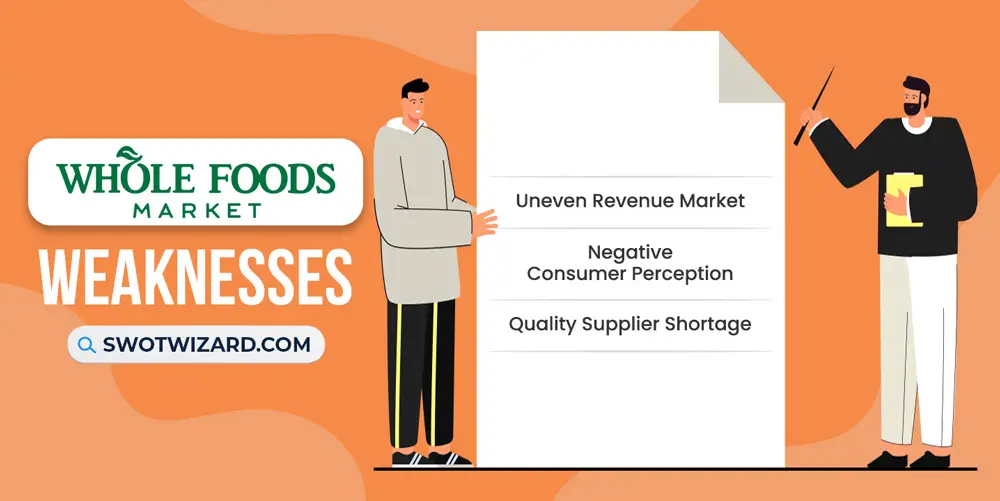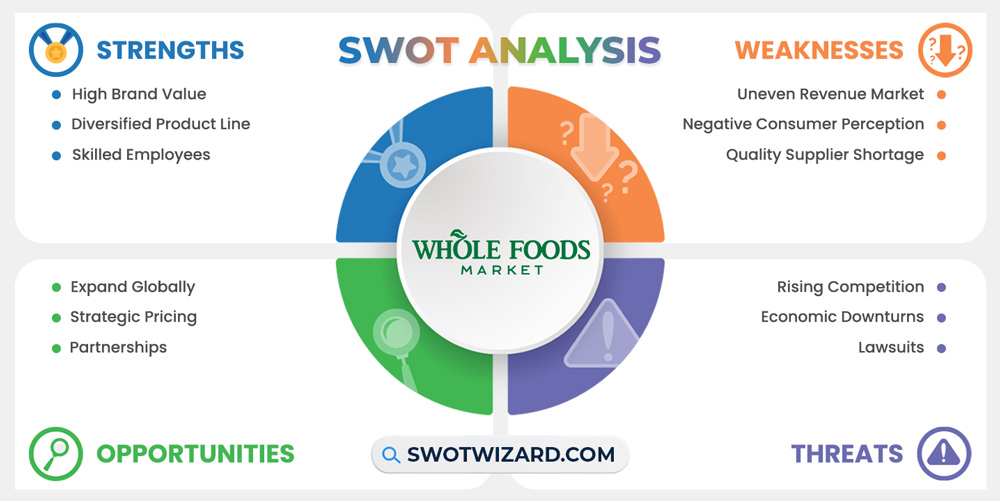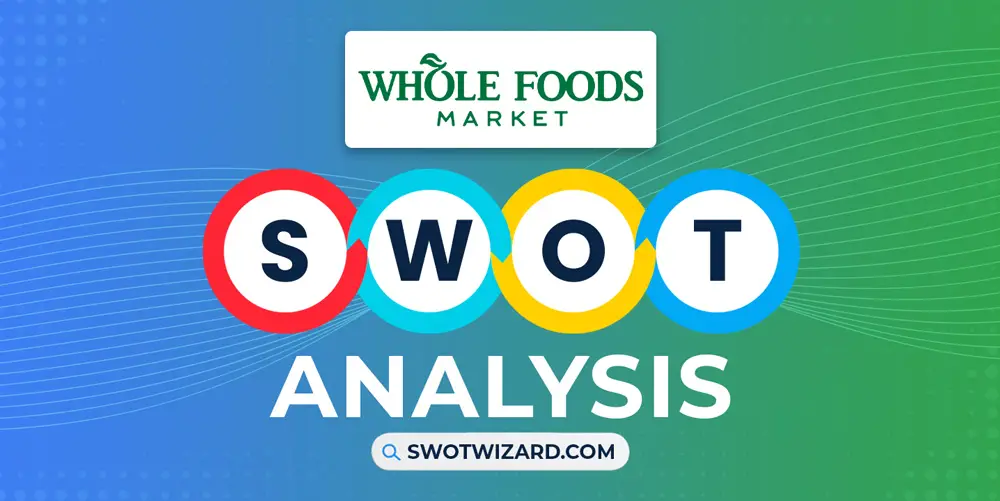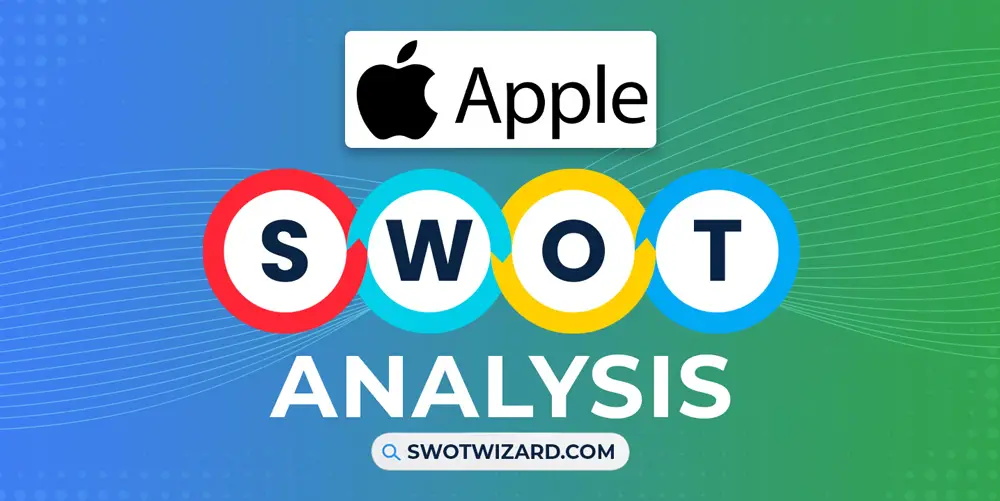Whole Foods has become one of the fastest-growing supermarket chains in the USA, and in the last two decades, the revenue has grown by 605.47%, which is massive. That happened because they timely grabbed some opportunities with strengths. But, there are more, which we will get to know in this Whole Foods swot analysis.
Whole Foods: Company Overview
| Company | Whole Foods Market, Inc. |
| Industry | Grocery |
| Founded | 20 September, 1980 |
| Founders | John Mackey, Renee Hardy-Lawson, Mark Skiles, Craig Weller |
| CEO | Jason Buechel |
| Headquarter | Austin, Texas, U.S. |
| No. of Employees | 91,000+ |
| Annual Revenue | $17 billion (FY 2021) |
| Website | wholefoodsmarket.com |
Like many other supermarket chain companies worldwide, Whole Foods also started its journey as a small store in Austin, Texas, called SaferWay. That wasn’t the birth year, as two years later, in 1980, they merged with another natural foods store called Clarksville Natural Grocery, and Whole Foods Market was born.
After that, in 33 years, Whole Foods Market has opened hundreds of locations across the United States, Canada, and the United Kingdom and has experienced steady revenue growth. According to data, the company generated $16B in total revenue and employed 105,000 people.
Product & Services of Whole Foods
Food | Pharmacy | Flowers | Alcohol | General Merchandise
Whole Foods Competitors
Kroger | Sprouts Farmers Market | Trader Joe’s | Raley’s | Publix | The Fresh Market | Instacart | Walmart
Did You Know?
Whole Foods Market has established strict animal welfare standards for their products, and they were the first national grocer in the United States to set a deadline for labeling all its products containing genetically modified organisms (GMOs) by 2018.
Strengths – Whole Foods SWOT Analysis

High Brand Value: The brand is associated with quality, trust, and a premium shopping experience and built a strong brand reputation over the years, known for its commitment to natural and organic products, sustainability, and healthy living. As a result, for quality assurance and high brand trust, the company has ranked as one of the top five most trusted grocery store brands in the USA.
Diversified Product Line: Whole Foods Market offers various products catering to various dietary needs and preferences, starting from fresh produce, meats, seafood, dairy products, and packaged goods and specialty items like gluten-free, vegan, and organic options, especially because of the diversification the brand could target and cater to, which allowed the company to target a broader customer base and adapt to evolving consumer trends.
Skilled Employees: The company invests in training programs to ensure its staff can provide exceptional customer service and offer valuable product information and recommendations. As a result, it can pride itself on having knowledgeable and passionate employees who are well-versed in natural and organic foods.
Weaknesses – Wh0le Foods SWOT Analysis

Uneven Revenue Market: Whole Foods Market has faced challenges in achieving consistent revenue growth across all its locations. As per the data, the company’s 90% of revenue comes from the US market alone, and as for international growth, the percentage is not more than 2%, which is very low.
Negative Consumer Perception: Despite efforts to shed the “Whole Paycheck” image, Whole Foods Market still grapples with the perception of being an expensive grocery option. As a result, it has deterred price-sensitive consumers from choosing Whole Foods, favoring lower-priced alternatives. Even they had to shut down the entire campaign for that.
Quality Supplier Shortage: As we all know, the company has been committed to providing natural and organic products and relies heavily on maintaining relationships with quality suppliers. But, disruptions in the supply chain due to various reasons in supplier agreements can impact the availability of certain products.
Opportunities – Whole Foods SWOT Analysis

Expand Globally: As we know, there is a limited international presence and growth, and Whole Foods Market has the opportunity to expand its presence in international markets. India and China look promising and could tap into growing consumer demand for natural and organic products.
Strategic Pricing: There are certain pricing strategic opportunities that Whole Foods Market can explore to attract a wider customer base. Offering competitive prices on select products or introducing value bundles can help dispel the perception of being overly expensive.
Partnerships: Collaborating with complementary brands can provide Whole Foods with new avenues for growth. Partnering with local farmers, suppliers, and food artisans can enhance the company’s commitment to supporting local communities.
Threats – Whole Foods SWOT Analysis

Rising Competition: With globalization, the entire scenario in every industry is changing, and in the case of the supermarket chain, Whole Foods Market faces increasing competition from traditional supermarkets and niche organic food stores. Kroger, Trader Joe’s, and Walmart have expanded their organic food offerings, attracting price-sensitive customers.
Economic Downturns: During the global financial crisis 2008, consumers shifted towards value-focused stores, impacting Whole Foods’ sales and financial performance. As a result, it threatens Whole Foods as their products often come at a premium price.
Lawsuits: Whole Foods Market faces the risk of lawsuits related to various issues, including product labeling, employee wages, and food safety. A few years ago, the company faced a class-action lawsuit alleging overcharging customers for pre-packaged food items.
[Bonus Infographic] SWOT Analysis of Whole Foods

Recommendations for Whole Foods
Among all the other giants in the supermarket chain industry, Whole Foods is rising with its strengths and opportunities. But, it will be difficult to grow and survive without addressing and overcoming the issues. That’s why;
- Implement targeted pricing strategies to enhance affordability without compromising quality.
- Continuously introduce new and unique products to stay ahead of competitors.
- Expand globally and enhance personalized experiences through loyalty programs and digital platforms.
- Further, invest in e-commerce capabilities and strategic partnerships to capture the growing online grocery market.
Frequently Asked Questions (FAQs)
Who Is The CEO of Whole Foods Now?
Jason Buechel is the CEO of Whole Foods now.
What Is The Biggest Whole Foods Store?
The biggest Whole Foods store is 80,000 square feet.
Final Words on Whole Foods SWOT Analysis
Whole Foods Market, a pioneer in natural and organic foods, faces challenges such as rising competition, economic downturns, and legal risks. To overcome these obstacles, the company should focus on price optimization, innovation, strategic partnerships, and e-commerce expansion. By adapting to evolving market dynamics, Whole Foods can maintain its position as a trusted provider of high-quality, sustainable products and continue to meet the needs of health-conscious consumers in a competitive retail landscape.
References
- Wikipedia contributors. (n.d.). Whole Foods Market. Wikipedia.
- Stempel, J. (2017, June 2). Lawsuit accusing Whole Foods of overcharging is revived: U.S. appeals court. Reuters.




